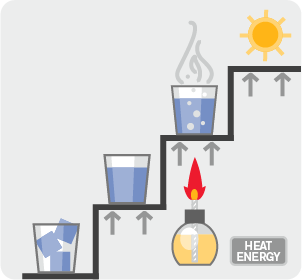The combination of cut quality, productivity, operating cost, and versatility make plasma arc cutting today’s most popular industrial cutting process.
What is plasma?
Plasma is the fourth state of matter. We normally think of three states of matter: solid, liquid and gas. For a common element, water, these three states are ice, water and steam.

The difference between these states is their relative energy levels. When you add energy in the form of heat to ice, the ice melts and forms water; if you add more energy, the water vaporizes and becomes steam. If you were to add considerably more energy to the steam – heating it to about 11,700° C – the steam would break up into a number of component gases, and would become electrically conductive, or ionized. This high energy ionized gas is called plasma.
What is plasma cutting?
A plasma cutter or plasma cutting system uses a plasma stream to transfer energy to a conductive work material. The plasma stream is typically formed by forcing a gas such as nitrogen, oxygen, argon — or even air — through a narrow nozzle. An electric current produced by an external power supply adds sufficient energy to the gas flow to ionize it, turning it into a plasma arc. This is why the process is often called plasma arc cutting. The plasma arc cuts the workpiece by first melting it, and then blowing away the molten metal.
How hot is a plasma cutter temperature?
The plasma arc produced by a plasma cutter or plasma cutting system produces temperatures approaching 40,000° F, so yes, the plasma cutter temperature is extremely high. In comparison, the surface of the sun is about 10,000° F.
How does a plasma cutter work?
A basic plasma cutter or plasma cutting system includes the following components:
- Power supply – A constant current DC power source. The open circuit voltage is typically in the range of 240 to 400 VDC. The output current (amperage) and overall kilowatt rating of the power supply determines the speed and cut thickness capability of the plasma cutter. The main function of the power supply is to provide the correct energy to maintain the plasma arc after ionization.
- Pilot arc starting circuit – In most liquid-cooled torches of 130 amps and higher, this is a high frequency generator circuit that produces an AC voltage of 5,000 to 10,000 volts at approximately 2 MHz. This voltage creates a high intensity pilot arc inside the torch to ionize the gas, producing the plasma. Rather than the high frequency starting circuit above, air plasma torches typically use a moving electrode, or “blowback start” technology to ionize the gas.
- Torch – This serves as the holder for the consumable nozzle and electrode, and provides cooling (either gas or water) to these parts. The nozzle and electrode constrict and maintain the plasma arc.
Plasma cutting software
For mechanized cutting applications, plasma cutting software is used to program the cutting machine. In some cases the CNC software can be used to program individual parts or small runs, but most fabricators and manufacturers rely on software commonly referred to as CAD/CAM nesting software which offers far greater features and capabilities.
Some types of CAD/CAM nesting software for plasma cutting can control and automatically set up virtually every aspect of the plasma cutting operation. For example, Hypertherm's ProNest® supports parameters such as arc current, voltage, gas preflow, cut flow settings, cut speeds, cut heights, pierce types, pierce heights, and more. All of this is intended to simplify the machine operator’s job and increase productivity.
Other features commonly found in plasma cutting software include:
- Collision avoidance
- Chain cutting
- Bridge cutting
- Common line cutting
- Multi-head cutting
- Skeleton cut-up
And in some cases the software can help deliver optimized outcomes such as:
- Improved hole quality
- Easier bevel set up
- Faster cycle time
Typical applications and industries
Plasma arc cutting is used in both handheld and mechanized systems to cut a wide range of conductive materials, including mild steel, carbon steel, stainless steel, aluminum, copper, brass, and other metals.
Cutting applications include:
- Straight cutting
- Bevel cutting
- Gouging
- Hole cutting
- Extended reach cutting and gouging
- Fine feature cutting
- Marking
Industries and markets include:
- Farming and ranching
- Shipbuilding
- Mining
- Energy
- HVAC and mechanical fabrication
- Steel service centers
- Construction equipment
- Automotive restoration
- Artwork, signs, and ornamentation
- Pipes and pipelines
- General construction
- Civil service construction
- General fabrication and job shops
Not sure which process or method to use?
You’ll find helpful information here:
Want to learn more about plasma
Take our free "Plasma Cutting Technology" eLearning course on the Hypertherm Cutting Institute


